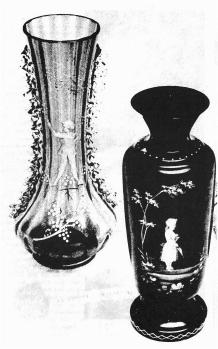National Depression Glass Association
Preserving America's Glass Manufacturing Heritage
Mary Gregory
by Jabe Tarter
Rainbow Review Glass Journal - November 1974
In the Boston Sadwith Glass Co., Mary Gregory plied her trade of painting figures of children on glass for a period of about twenty years. She seems to have been the head of the decorating shop which turned out hundreds of figures of children at piay, painted in white enamel.
 The paintings were done in white glaze, then fired just enough to
set the paint. There was not any color included in her art. She
depended on the color of the glass itself to lend color to her
paintings.
The paintings were done in white glaze, then fired just enough to
set the paint. There was not any color included in her art. She
depended on the color of the glass itself to lend color to her
paintings.
Mary Gregory was a spinster who delighted in the different forms children took when they wete dancing or playing. The entire scene was a complete setting with trees, flowers and grass.
Her work was done in the 1886 to 1888 period, only about two years. But a massive amount of this painted glass appears to have been made.
Her type and style of paintint originated in Europe in the early 1880s. It took its flavor from the Bohemian-style painting coming from that country from early 1870 to 1880. Not much of the original from Bohemia is around. But because it was a lesser expensive glass, it was destroyed.
It is easy to know one of the original Mary Gregory pieces if one remembers the important points of her paintings. They were always in white. The faces of the children were complete in their happy young faces. And the setting was complete. A tree came up and over the head of the child. And even though the grass and flowers were sparse, they completed the picture.
No color wet ever added to the faces or scenes done by Mary Gregory. Deming Jarves, inventor of glass pressing in 1826 in Boston Sandwich, left the firm and started another across the river from the old Sandwich Glass Co.
In Bedford, color was added to the cheeks of the children. And a mist of color was sometimes added to the background or setting of the piece.
There are those who believe Mary Gregory never existed at all, that she was a sales gimmick to sell more glass. Because the figures were of children, and because children are an instant success whereever they are displayed, the so-called Mary Gregory was an instant hit.
Proof of her existance is shown in the book on Mary Gregory glass in the duplicate of her birth certificate. So, she actually did exist, and worked at the Sandwich Glass Co. turning out her art on beautiful glassware.
There is a great deal of glass coming on the market now accredited to Mary Gregory.
The new glass, coming From Germany, England, Italy and Japan, with the United States giving her share are coming on the market. They are dubbed as old Mary Gregory but close examination prevents error.
On the newer ones, it is obviously an attempt to cash in on the popularity of Mary Gregory Glass. The paint is not smooth. Sometimes the legs are so thick and hasty as to show varicose veins. The faces are blobs of paint without character of a carefully done piece. And color in strong tones is sometimes added.
If Mary gregory had worked eight days a week, fourteen hours a day and 400 days a year, it wouldn't have been possible for her to produce as much glass as that coming on the market under her name.
Glass from the 1880 period from Sandwich Glass Co. is interesting and to collect. Just be certain you are collecting the real thing, and not some thing passed of from the import houses around the country.